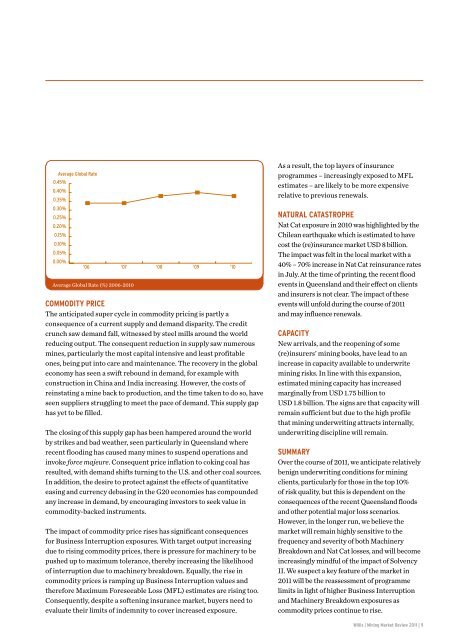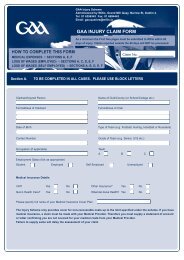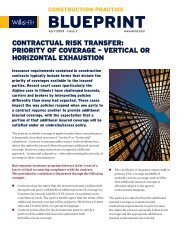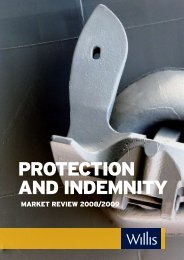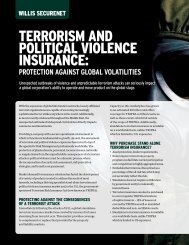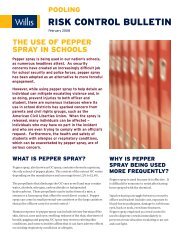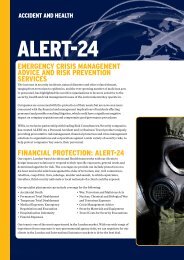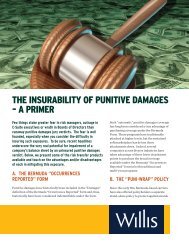spRING 2011 GlobAl MARKETs INTERNATIoNAl - Willis
spRING 2011 GlobAl MARKETs INTERNATIoNAl - Willis
spRING 2011 GlobAl MARKETs INTERNATIoNAl - Willis
You also want an ePaper? Increase the reach of your titles
YUMPU automatically turns print PDFs into web optimized ePapers that Google loves.
5<br />
Average Global Rate<br />
0.45%<br />
0.40%<br />
0.35%<br />
0.30%<br />
0.25%<br />
0.20%<br />
0.15%<br />
0.10%<br />
0.05%<br />
0.00%<br />
‘06 ‘07 ‘08 ‘09 ‘10<br />
Average Global Rate (%) 2006-2010<br />
CoMModity PRiCe<br />
The anticipated super cycle in commodity pricing is partly a<br />
consequence of a current supply and demand disparity. The credit<br />
crunch saw demand fall, witnessed by steel mills around the world<br />
reducing output. The consequent reduction in supply saw numerous<br />
mines, particularly the most capital intensive and least profitable<br />
ones, being put into care and maintenance. The recovery in the global<br />
economy has seen a swift rebound in demand, for example with<br />
construction in China and India increasing. However, the costs of<br />
reinstating a mine back to production, and the time taken to do so, have<br />
seen suppliers struggling to meet the pace of demand. This supply gap<br />
has yet to be filled.<br />
The closing of this supply gap has been hampered around the world<br />
by strikes and bad weather, seen particularly in Queensland where<br />
recent flooding has caused many mines to suspend operations and<br />
invoke force majeure. Consequent price inflation to coking coal has<br />
resulted, with demand shifts turning to the U.S. and other coal sources.<br />
In addition, the desire to protect against the effects of quantitative<br />
easing and currency debasing in the G20 economies has compounded<br />
any increase in demand, by encouraging investors to seek value in<br />
commodity-backed instruments.<br />
The impact of commodity price rises has significant consequences<br />
for Business Interruption exposures. With target output increasing<br />
due to rising commodity prices, there is pressure for machinery to be<br />
pushed up to maximum tolerance, thereby increasing the likelihood<br />
of interruption due to machinery breakdown. Equally, the rise in<br />
commodity prices is ramping up Business Interruption values and<br />
therefore Maximum Foreseeable Loss (MFL) estimates are rising too.<br />
Consequently, despite a softening insurance market, buyers need to<br />
evaluate their limits of indemnity to cover increased exposure.<br />
As a result, the top layers of insurance<br />
programmes – increasingly exposed to MFL<br />
estimates – are likely to be more expensive<br />
relative to previous renewals.<br />
NatuRal CatastRoPhe<br />
Nat Cat exposure in 2010 was highlighted by the<br />
Chilean earthquake which is estimated to have<br />
cost the (re)insurance market USD 8 billion.<br />
The impact was felt in the local market with a<br />
40% – 70% increase in Nat Cat reinsurance rates<br />
in July. At the time of printing, the recent flood<br />
events in Queensland and their effect on clients<br />
and insurers is not clear. The impact of these<br />
events will unfold during the course of <strong>2011</strong><br />
and may influence renewals.<br />
CaPaCity<br />
New arrivals, and the reopening of some<br />
(re)insurers’ mining books, have lead to an<br />
increase in capacity available to underwrite<br />
mining risks. In line with this expansion,<br />
estimated mining capacity has increased<br />
marginally from USD 1.75 billion to<br />
USD 1.8 billion. The signs are that capacity will<br />
remain sufficient but due to the high profile<br />
that mining underwriting attracts internally,<br />
underwriting discipline will remain.<br />
suMMaRy<br />
Over the course of <strong>2011</strong>, we anticipate relatively<br />
benign underwriting conditions for mining<br />
clients, particularly for those in the top 10%<br />
of risk quality, but this is dependent on the<br />
consequences of the recent Queensland floods<br />
and other potential major loss scenarios.<br />
However, in the longer run, we believe the<br />
market will remain highly sensitive to the<br />
frequency and severity of both Machinery<br />
Breakdown and Nat Cat losses, and will become<br />
increasingly mindful of the impact of Solvency<br />
II. We suspect a key feature of the market in<br />
<strong>2011</strong> will be the reassessment of programme<br />
limits in light of higher Business Interruption<br />
and Machinery Breakdown exposures as<br />
commodity prices continue to rise.<br />
<strong>Willis</strong> | Mining Market Review <strong>2011</strong> |


